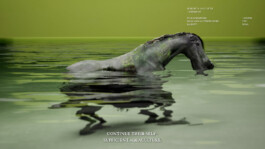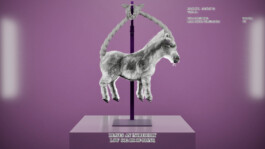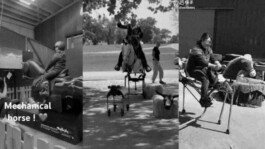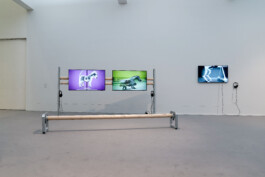



5 channel video
approx. 25 min
work in progress
2024/2025


[E]
The CO2-efficient handbag horse, the long-legged high water horse, the Libyan algae horse and the genetically manipulated primeval horse: these four potential horses of the future are being developed in collaboration with palaeontologists from the UNESCO World Heritage Site Grube Messel based on scientific findings. They are the results of targeted breeding, genetic manipulation, and environmental alternations due to climate change. As the main protagonists of a 3D-animated video installation, they inhabit four distinct future habitats and present their survival tactics.
Using the example of the horse, one of humanity’s oldest companions, the work questions the future of domestic animals as they disappear as such, and examines the influence of humans on nature and the environment, even after the Anthropocene. Combining elements of evolutionary research and science fiction, the project explores themes of resilience and coping strategies while highlighting the role of females in the animal kingdom.
[D]
Das CO2-effiziente Handtaschenpferd, das langbeinige Hochwasserross, der libysche Algengaul und das genmanipulierte Urpferdchen: Diese vier potenziellen Pferde der Zukunft werden in Zusammenarbeit mit Paläontolog*innen des UNESCO-Welterbes Grube Messel auf der Grundlage wissenschaftlicher Erkenntnisse entwickelt. Sie sind das Ergebnis von gezielter Zucht, Genmanipulation und Umweltveränderungen durch den Klimawandel. Als Hauptprotagonist*innen einer 3D-animierten Videoinstallation bewohnen sie vier unterschiedliche zukünftige Lebensräume und stellen ihre Überlebenstaktiken vor.
Am Beispiel des Pferdes, einem der ältesten Gefährten des Menschen, hinterfragt die Arbeit die Zukunft von Haustieren, wenn diese als solche verschwinden, und untersucht den Einfluss des Menschen auf Natur und Umwelt auch nach dem Anthropozän. Das Projekt verbindet Elemente der Evolutionsforschung und der Science-Fiction und erforscht Themen wie Widerstandsfähigkeit und Coping-Strategien, während es die Rolle der Weibchen im Tierreich hervorhebt.

Installation view by Daniela Wolf
"Beyond Soundscapes"at Museum Kleishues-Bau






5 channel video
approx. 25 min
work in progress
2024/2025
[E]
The CO2-efficient handbag horse, the long-legged high water horse, the Libyan algae horse and the genetically manipulated primeval horse: these four potential horses of the future are being developed in collaboration with palaeontologists from the UNESCO World Heritage Site Grube Messel based on scientific findings. They are the results of targeted breeding, genetic manipulation, and environmental alternations due to climate change. As the main protagonists of a 3D-animated video installation, they inhabit four distinct future habitats and present their survival tactics.
Using the example of the horse, one of humanity’s oldest companions, the work questions the future of domestic animals as they disappear as such, and examines the influence of humans on nature and the environment, even after the Anthropocene. Combining elements of evolutionary research and science fiction, the project explores themes of resilience and coping strategies while highlighting the role of females in the animal kingdom.
[D]
Das CO2-effiziente Handtaschenpferd, das langbeinige Hochwasserross, der libysche Algengaul und das genmanipulierte Urpferdchen: Diese vier potenziellen Pferde der Zukunft werden in Zusammenarbeit mit Paläontolog*innen des UNESCO-Welterbes Grube Messel auf der Grundlage wissenschaftlicher Erkenntnisse entwickelt. Sie sind das Ergebnis von gezielter Zucht, Genmanipulation und Umweltveränderungen durch den Klimawandel. Als Hauptprotagonist*innen einer 3D-animierten Videoinstallation bewohnen sie vier unterschiedliche zukünftige Lebensräume und stellen ihre Überlebenstaktiken vor.
Am Beispiel des Pferdes, einem der ältesten Gefährten des Menschen, hinterfragt die Arbeit die Zukunft von Haustieren, wenn diese als solche verschwinden, und untersucht den Einfluss des Menschen auf Natur und Umwelt auch nach dem Anthropozän. Das Projekt verbindet Elemente der Evolutionsforschung und der Science-Fiction und erforscht Themen wie Widerstandsfähigkeit und Coping-Strategien, während es die Rolle der Weibchen im Tierreich hervorhebt.

Installation view by Daniela Wolf "Beyond Soundscapes"at Museum Kleishues-Bau